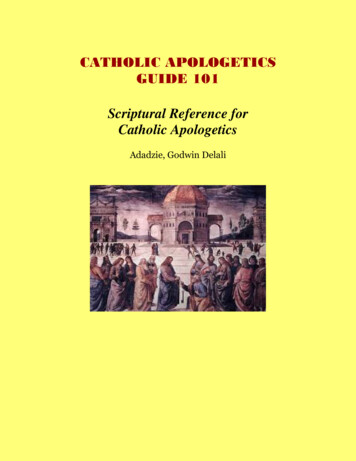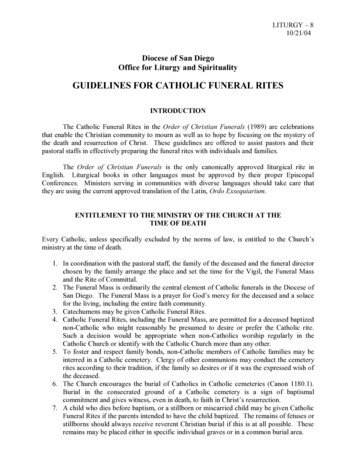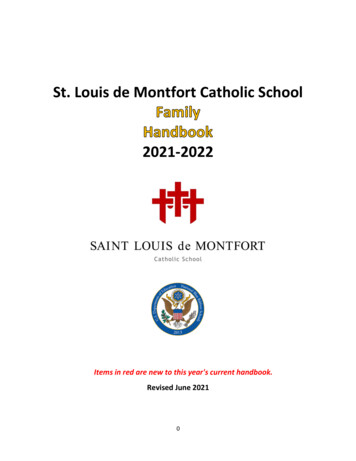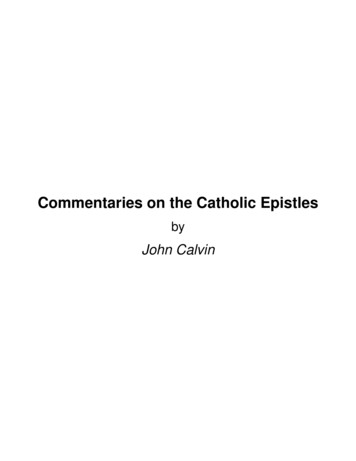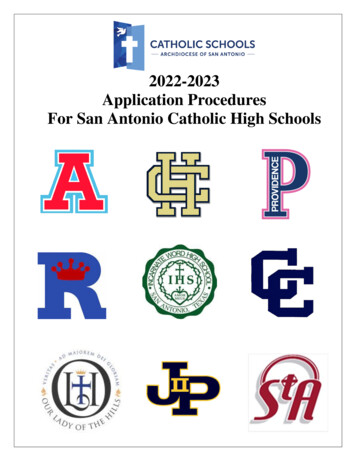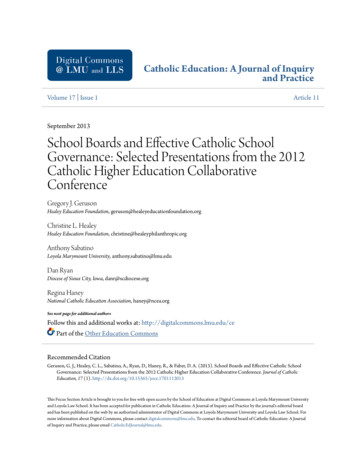
Transcription
Catholic Education: A Journal of Inquiryand PracticeVolume 17 Issue 1Article 11September 2013School Boards and Effective Catholic SchoolGovernance: Selected Presentations from the 2012Catholic Higher Education CollaborativeConferenceGregory J. GerusonHealey Education Foundation, geruson@healeyeducationfoundation.orgChristine L. HealeyHealey Education Foundation, christine@healeyphilanthropic.orgAnthony SabatinoLoyola Marymount University, anthony.sabatino@lmu.eduDan RyanDiocese of Sioux City, Iowa, danr@scdiocese.orgRegina HaneyNational Catholic Education Association, haney@ncea.orgSee next page for additional authorsFollow this and additional works at: http://digitalcommons.lmu.edu/cePart of the Other Education CommonsRecommended CitationGeruson, G. J., Healey, C. L., Sabatino, A., Ryan, D., Haney, R., & Faber, D. A. (2013). School Boards and Effective Catholic SchoolGovernance: Selected Presentations from the 2012 Catholic Higher Education Collaborative Conference. Journal of CatholicEducation, 17 (1). http://dx.doi.org/10.15365/joce.1701112013This Focus Section Article is brought to you for free with open access by the School of Education at Digital Commons at Loyola Marymount Universityand Loyola Law School. It has been accepted for publication in Catholic Education: A Journal of Inquiry and Practice by the journal's editorial boardand has been published on the web by an authorized administrator of Digital Commons at Loyola Marymount University and Loyola Law School. Formore information about Digital Commons, please contact digitalcommons@lmu.edu. To contact the editorial board of Catholic Education: A Journalof Inquiry and Practice, please email CatholicEdJournal@lmu.edu.
School Boards and Effective Catholic School Governance: SelectedPresentations from the 2012 Catholic Higher Education CollaborativeConferenceCover Page FootnoteSuggested citations: Geruson, G. J. & Healey, C. L. (2013). Sustaining Catholic schools: Ten essentials forstartup boards. Catholic Education: A Journal of Inquiry and Practice, 17(1), 188-198. Sabatino, A., Ryan, D.,& Haney, R. (2013). Strategic restructuring of school boards in the Diocese of Sioux City: A model fordeveloping a community of committee-driven Catholic school boards. Catholic Education: A Journal ofInquiry and Practice, 17(1), 199-209. Faber, D. (2013). Panel discussion on small and rural schoolgovernance. Catholic Education: A Journal of Inquiry and Practice, 17(1), 210-213.AuthorsGregory J. Geruson, Christine L. Healey, Anthony Sabatino, Dan Ryan, Regina Haney, and David A. FaberThis focus section article is available in Catholic Education: A Journal of Inquiry and Practice: http://digitalcommons.lmu.edu/ce/vol17/iss1/11
186Catholic Education / September 2013School Boards and Effective Catholic School Governance:Selected Presentations from the 2012 Catholic HigherEducation Collaborative ConferenceThe following article contains essays derived from presentations delivered to theCatholic Higher Education Collaborative (CHEC) Conference held at MarquetteUniversity in October 2012. The three essays included in this collection focus onnew approaches to school board development and functioning that are changing Catholic school governance. The first essay, “Sustaining Catholic Schools: TenEssentials for Startup Boards,” is written by Gregory J. Geruson and ChristineL. Healey of the Healey Education Foundation. The authors discuss the work ofthe Foundation to improve the effectiveness of Catholic school boards through theestablishment of boards of limited jurisdiction with actual authority over schoolpolicy, finances, and governance. The essay includes 10 essential “must haves” forboards based on the Foundation’s experiences working with nearly 60 Catholicschools in the Northeastern the United States.Next, Anthony Sabatino of Loyola Marymount University, Dan Ryanof the Diocese of Sioux City, Iowa, and Regina Haney of the National CatholicEducational Association discuss the establishment of committee-driven boards intheir essay, “Strategic Restructuring of School Boards in the Diocese of Sioux City:A Model for Developing a Community of Committee-Driven Catholic SchoolBoards.” This essay discusses how the diocese utilized regional teams, representingprincipals, administrators, and individual school board members, to develop along-term strategic plan for the diocese through a committee-based, data-drivenprocess. According to the authors, the process has improved how individual schoolboards use data, address issues and create long term plans for their individualschools.Finally, David Faber, Superintendent of Schools in the Diocese of GrandRapids, Michigan, discusses “virtual consolidation through satellite schools”—anew approach the Diocese has implemented with regard to school governance. Faber reviews the consolidation of three schools, which maintained the three schoolsites under the management of one administrator and shared services. An integralpart of this change was moving toward more personalized educational optionsfor students, including one-to-one computing and blended learning. Central tothis transition was disbanding the individual consultative boards for each of theschools and creating a new board of limited jurisdiction to govern the three satelCatholic Education: A Journal of Inquiry and Practice, Vol. 17, No. 1, September 2013, 186-213.
School Boards and Effective Catholic School Governance187lite schools. To ensure that local concerns are addressed, the new board structureincludes three committees, representing the interests of each of the individual sites.These changes have led to increased enrollment at the three sites and the reductionof total expenses by nearly 20%.These three essays reinforce the role that school boards play in the effectivemanagement and governance of Catholic schools. Carefully considering the needsof individual schools—and ensuring that boards have the right mix of skills andcompetencies to address those needs—is imperative for the long-term sustainability of Catholic K-12 schools.
188Catholic Education / September 2013Sustaining Catholic Schools: Ten Essentials forStartup BoardsGregory J. Geruson and Christine L. HealeyHealey Education Foundation, Catholic School Development ProgramMt. Laurel, New JerseyBoards play a pivotal role in a Catholic elementary or high school’s ability to takecharge of its own future. Of the more than 55 schools served by the Healey Education Foundation’s Catholic School Development Program since 2004, those thathave achieved measurable results through boards of limited jurisdiction have hadin common some essential attitudes and approaches. The overarching goal is thelong-term sustainability of their schools. This essay outlines 10 essential practicesfor startup boards—including mission focus, serving as doers and donors, makingdata-informed decisions, thinking strategically, and acting with urgency—thatcan be especially helpful to new boards in schools ready to change.The need for local, regional, and diocesan boards has become a commontheme in conversations about new and promising models of Catholic schoolgovernance. A new board can mark a critical crossroads for a school ready totake ownership of its own future, yet its formation alone offers no guaranteethat the path toward sustainability is certain. Much of the right work remainsto be done.Of the more than 55 schools served by the Healey Education Foundation’s Catholic School Development Program (CSDP) since 2004, nearly allhave implemented new boards of limited jurisdiction as an essential part ofa broader strategy employing other best practices: strong leadership, soundfundraising, strategic enrollment marketing, and a mission-driven, datainformed culture. Unlike advisory boards that have no official authority butfunction to make recommendations, advise on policy, and foster participationand engagement, boards of limited jurisdiction have official authority overschool governance. In our experience, boards of limited jurisdiction that areaccountable for the governance and financial health of schools foster greaterengagement and long-term sustainability. These boards offer a stark contrast to the days when members listened and discussed but stopped short ofimplementing real change.
School Boards and Effective Catholic School Governance189CSDP has guided schools through the transformative process of establishing and maintaining boards that have official authority and that entrustthe laity with decision making, policy making, and financial accountability.What these schools have learned and practiced can be helpful to others justbeginning. In this essay, we outline 10 essential practices for startup boardsdrawn from our experiences working with schools. Our recommendationsfall into three categories: purpose, people, and execution. Together, these recommendations provide a comprehensive guide to creating and maintaining asuccessful board and fostering effective relationships between the board andthe rest of the school community.A successful startup makes it possible from the outset for the board to actin the best interest of the school. With the right goals, strategies, and tactics, an empowered board at any stage of its development is equipped to dotoday’s job well while anticipating tomorrow’s needs.The PurposeThe first two essential practices highlighted in this article relate to understanding the purpose of the board and its role in supporting the missionof the school. The role of a board of limited jurisdiction can be enhancedthrough a clear focus on sustainability, a mindset open to innovation, and acommitment to mission-driven leadership and decision making.Essential Practice #1: Be Change Agents for SustainabilityIn an environment in which Catholic schools continue to close at an alarming rate—due in part to an obsolete business model—the board is entrustedwith establishing clear priorities around the overarching goal of sustainability.The leadership team creating the board understands that the school’s abilityto thrive long-term starts with this goal and requires an accompanying disposition: the willingness to change.The old ways of governance no longer work. Successful boards are opento new and expansive ways of achieving the goal of sustainability in orderto continue serving children. Boards initiated without this focus and openmindset are operating at a disadvantage and can become easily sidetracked.Too often, startup boards get caught up in the details of certain special issues(e.g., changing the uniform or improving the athletic policy), instead of tack-
190Catholic Education / September 2013ling pressing issues directly related to sustainability, such as managing thebudget, improving marketing, and ensuring strong leadership.Essential Practice #2: Embrace the School’s MissionA mission-driven board stays on course. Each school’s identity and competitive advantage begin with its mission. Some schools have an incomplete,wordy, or confusing mission statement that exists somewhere in writing,possibly even hanging in a frame, but is seldom consulted or shared. Ideally,the school’s mission is owned by members of the school community (parents, students, faculty, alumni, parishioners, principals, and pastors) who haveestablished resonses to the following questions: Who are we? What do we do? Who do we aspire to be? What makes us unique?In the best of circumstances, a school has a mission in place before theboard is formed so that the member selection process can be informed bythe mission. If not, the board must quickly work with the school leadership to establish a clear and compelling mission around which the schoolcan rally. Decisions for the school are then made in the context of advancing the mission.In a CSDP website post entitled “Principals Discuss Today’s Requirements,” Sr. Jerilyn Einstein, FMIJ, principal of Guardian Angels RegionalSchool, Gibbstown and Paulsboro, N.J., has explained:Always return to the school’s mission. The pedagogy of our foundress,Barbara Micarelli, in the Catholic Franciscan tradition, centers onlove, concern, respect, and hospitality. When parents call, when theyand their children walk in the door, they can hear, see, and experiencethat. We attempt to live those values consistently through a family atmosphere and respectful dialogue. (“Principals Discuss,” 2012, para. 5)
School Boards and Effective Catholic School Governance191The PeopleEssential practices three through six are related to the constitution of theboard. Choosing the right board members is a delicate balance requiringconsideration of the school’s needs and the prospective members’ strengths,weaknesses, and interests. Once in place, supporting relationships betweenthe board and school leadership is important to achieving successful collaborative work.Essential Practice # 3: Select Members Based on the School’s NeedsSelecting members has especially far-reaching consequences when starting anew board because every seat is open. A commonly used tool is a board composition matrix, which lists skills, competencies, and demographic categoriesthat should be filled by potential members. We believe that this tool is bestapplied in a broader context. In the article “Ditch Your Board Composition Matrix,” Masaoka (2012) offered an alternative for the nonprofit board:define the top three goals for the board by identifying the institution’s mostpressing needs. Selecting board members then becomes a matter of invitingpeople with the skills, knowledge, and resources to help achieve those goals.By shifting focus from who people are to what the school needs them to do,schools may achieve the following: Expand the “field of sight” in recruiting for the board. As Masaoka haswritten, “Rather than just looking for someone in marketing, we [schoolleaders] think more widely and include bloggers, writers, communityorganizers.” Select members based on skills, rather than background or demographics.According to Masaoka, this criteria can prevent “recruiting someone withthe right demographics or professional background or financial meansbut who can’t or won’t do what we [school leaders] have mistakenly assumed they could or would ” Direct attention and resources to the immediate needs of the organization. (Masaoka, 2012, para. 15)This approach can help schools avoid two other potential traps: one, believing that the board is strictly the domain of parents; the other, thinking of boardmembers as elected or representative advocates of particular constituencies.
192Catholic Education / September 2013For example, one regional school with which CSDP consulted incorrectly assumed that the board seats should be evenly divided among threesupporting parishes. While it was important for prospects to be consideredfrom all areas served, the school adjusted its thinking to choose membersfor their expertise related to the specific needs of the school rather than fortheir representation.Essential Practice #4: Engage the Pastor as a BoardMember and AdvocateUnlike the traditional model for managing Catholic schools, in the board oflimited jurisdiction model, the pastor no longer has the final say in schoolpolicies and operations; however he still plays a significant role. The pastor maintains specific canonical authority as designated by the bishop. As aboard member, the pastor attends meetings, expresses views, and casts onevote. As a leader of the parish, he manages key connections between theparish and school communities and remains fully engaged in promoting theschool.In two major shifts, the board drives the processes of hiring a new principal and developing the school budget. In selecting the principal, a committeeof the board conducts the search; the pastor plays a vital role on this committee, but final approval of the board is required before hiring. For the budget,the pastor serves as a key manager between the parish council and the boardand determines what percentage of parish support the school receives.While it may be challenging for some pastors, relinquishing this controlfrees their time to attend to other parish priorities and enables schools tobenefit from the talents and business acumen of others. The changing role ofthe pastor sometimes presents more challenges to board members—who areinclined to ask for permission—than to the pastor himself. Anecdotally, somepastors are thrilled and even relieved by the professional contributions madeto the strategic planning, financial management, and development of theschool, a living and visible mission of the Church and parish.For Rev. Paul M. Kennedy, pastor of St. Katherine of Siena School, Philadelphia, the most rewarding personal experience during a year of majortransition for the school was in the building of the board of limited jurisdiction. As he described in a CSDP website post: “Having been here eight years,I really enjoyed asking people to step forward and take on leadership roles.Saint Katherine’s isn’t any one person; it is all of us” (“Philadelphia YieldsEnrollment,” 2012, para. 16).
School Boards and Effective Catholic School Governance193Essential Practice #5: Recruit a Balance of Doers and DonorsMost schools need a combination of doers and donors on the board; peoplewith influence and affluence who, ideally, can both offer the time and talent toget things done and commit financially to the school.Engaged board members get involved quickly by sharing their intelligence and experience. New board members should listen well, learn about theschool as a whole—rather than solely through their own world view, ask theright questions around the mission and needs of students, and “never settlefor answers like ‘We have always done it this way’” (DeKuyper, 2007, p. 20).As long as they are board members, they should make the school a priority intheir charitable giving (Ingram, 2009).By being deliberate about choosing board members, especially at startup,schools can involve people who will help achieve the mission. How theschool asks a potential board member to join sets the tone for the relationship and role moving forward. This is not about asking a favor of someone;rather, it requires a series of conversations about why the candidate is achoice and how he or she can contribute.Essential Practice #6: Empower Leaders to LeadBoards of limited jurisdiction are entrusted with the authority to make decisions. They must be able to rely on strong leadership at every level: pastor,principal, advancement director, board members, and board chair.As the inspirational leader and chief marketing officer of the school, theprincipal articulates the school’s needs as priorities and opportunities toshape the future. The advancement director owns and leads enrollment management, fundraising, communications, and constituent relations.A strong relationship among the board, its membership, and the chair,and the principal ensures that all act together upon the school’s best interest.Steve Hogan, principal of Saint Mary’s School, Vineland, N.J., explained:We need a group of people who are passionate about the mission andvision of the school. It’s very important to remain positive and to realize that everyone is a part of advancement – not just the person in theadvancement director’s office. We all work together and need to takeownership of the school’s advancement goals. Schools need to havea protocol for reaching out to people. This certainly means having
194Catholic Education / September 2013procedures for enrollment management. But it can also mean beingintentional about reaching out to a broader audience in the community. (“Principals Discuss,” 2012, para. 10–11)Having strong leaders in place at all levels of management and governance isimportant to a school’s ongoing success and sustainability.The ExecutionOur last four recommended practices have to do with the work of the boardand the structures put in place for them to carry out their work. Creating andsustaining an efficient and effective board requires forethought into practicesas well as ongoing assessment and reflection on the board’s achievements andshortcomings.Essential Practice #7: Remember that Structure MattersIn considering configurations and governance models that may be effective,CSPD and others engaged in the work of Catholic school sustainability haveresearched best practices and trends. These have included the changing rolesand reach of school boards, including: “shifts in authority, purpose, and responsibilities, in membership composition, and in the increased use of committees” (Haney, 2010, p. 198).Structure matters, not only as the governance model is established, butalso as the board begins its work and learns to operate efficiently and effectively. Bylaws or operating principles govern what is and is not within theboard’s jurisdiction. By clearly delineating the scope and level of the board’sauthority and control, bylaws or operating principles provide a structure forempowered decisionmaking in the school’s best interests. Furthermore, thisstructure ensures that authority is invested in the board as a whole, and not inany individual member.Boards decide, committees do the work, and agendas rule. With suchdiscipline, board members focus on identifying priorities, determining a sequence of actions, and creating and documenting processes for accomplishingthe desired work goals: Priorities: A straightforward yet determined course of action is to affirmthe mission, identify the priority needs of the school around sustain-
School Boards and Effective Catholic School Governance195ability, set goals, and assign committees to do the work. Goals should bemeasurable, attainable, but also a “stretch” to encourage ongoing advancement. Sequencing: The order for getting things done varies by school. A startupboard should neither be in search of something to do nor take on everything at once. Many schools with which CSDP has worked have formeda finance committee first to provide desperately needed help with budgeting, establishing financial controls, and reporting. An enrollmentmarketing committee often follows. Process: Hiring a new principal, collecting tuition, governing meetings,selecting board members, budgeting; all such activities benefit from adocumented process. Some processes are established in advance; othersare determined by the board.Essential Practice #8: Clarify Roles and Work as PartnersA startup board has a golden opportunity to create its own culture while advancing the mission of the school. An initial temptation is to take on the roleof administrative advisors who tell the principal everything he or she shoulddo. However, board members must understand what is not within their jobdescription (for example, administrative issues, operational policies, personnelissues concerning faculty and staff, and student discipline).The preferred and productive approach is one of partnership and collaboration. An effective board member always supports the board’s decisionoutside the boardroom. Debates and discussions are confidential, direct dealing, open, and honest.In a typical scenario for CSDP schools, the board consists of 15 to 21voting members with board-elected officers: chair, vice chair, secretary, andtreasurer. The board identifies issues for the committees and allows work tobe done in committee and brought back to the board. This enables the mosteffective and efficient use of members’ time and talents. Board committeeshave a clear and concise charge (executive and board membership, finance,development, enrollment, facilities) and work with the school leadership toset and achieve goals. Each has a chairperson, who reports progress and nextsteps to the board.Board members can learn how to clarify their roles to maintain a higherlevel of engagement and influence. In a website post on board training, BethAlfonsi, CSDP Assistant Director, explained: “If approached by a disgruntled
196Catholic Education / September 2013parent on a specific grievance, for instance, a board member should directthat person to the principal or other appropriate channel” to avoid “gettingmired down in issues that should be resolved elsewhere” (“Board TrainingInforms,” 2011, para. 4).Essential Practice #9: Make Data-Informed DecisionsEffective boards base their decisions on information and data, not stories andanecdotes. Often, the school brings data to the board, and the board appliesknowledge and expertise to address the challenges. The board evaluates whathas already happened in order to determine what needs to happen next.For example, a new board at one school working with CSDP recentlysigned off on a revamped finance process that involved a transition to accrualbasis accounting and separating the school’s budget from the parish’s numbers. This more transparent reporting enabled the school to announce andexplain the need for a tuition increase and to move forward with financialplanning based on the true cost of operations.Essential Practice #10: Think Strategically and Act with UrgencyA focused board thinks strategically in managing its immediate priorities. Itremains invested in the school’s mission and future, even when the strategicplan itself takes a back seat.One school working with CSDP recently sidestepped the common butill-timed tendency to launch an involved strategic planning process when itbecame clear that its new board had to act now. The school needed immediate decisions and approaches to create a budget, manage enrollment, andintroduce annual giving. In the course of addressing these pressing concerns,the board learned more about the school’s history and current situation andwas then in a better position to plan strategically for the future than it wouldhave been at the outset.Effective boards have a bias for action. They set goals, decide how toachieve them, and carefully manage time and resources to execute on theirpriorities.
School Boards and Effective Catholic School Governance197ConclusionCatholic school board members can benefit from advice shared with all nonprofit boards: “Avoid dysfunctional politeness . . . Know what your organization does and whom it serves . . . Never miss an opportunity to say somethinggood about your organization . . . Go beyond compliance. Do the right thingat all times” (Ingram, 2009, p. 68).In the current environment, in which needs are many and resources arefew, the board plays a crucial role in affirming and advancing the mission ofthe school, providing leadership, and offering new perspectives and insights.On the path to sustainability, the board’s success takes many forms: increasedlevels of engagement, broader bases of support, sound business practices,transparency, and accountability. By establishing a board that lives the 10 essential practices outlined in this essay, the school sets a solid foundation onwhich to build its own future.ReferencesCatholic School Development Program. (2011, March 16). Board training informs and inspires.Retrieved from -informs-andinspiresCatholic School Development Program. (2012, September 18). Philadelphia yields enrollmentincreases and enthusiasm. Retrieved from ields-enrollment-increases-enthusiasmCatholic School Development Program. (2012, May 12). Principals discuss today’srequirements. Retrieved from cusstoday%E2%80%99s-requirementsDeKuyper, M. H. (2007). Trustee handbook, a guide to effective governance for independent schoolboards (9th ed.). Washington, DC: National Association of Independent Schools.Haney, R. M. (2010). Design for success: New configurations and governance models forCatholic schools. Catholic Education: A Journal of Inquiry and Practice, 14(2), 195–211.Ingram, R. T. (2009). Ten basic responsibilities of nonprofit boards (2nd ed.). Washington, DC:BoardSource.Masaoka, J. (2012, June 11). Ditch your board composition matrix. In Blue Avocado, Magazineof American Nonprofits. Retrieved from http://www.blueavocado.org/node/762
198Catholic Education / September 2013Gregory J. Geruson is the vice president of the Healey Education Foundation andCatholic School Development Program. Christine L. Healey is the president ofthe Healey Education Foundation. She also serves as board chair, Catholic Partnership Schools, and is co-founder of We Can Do Better New Jersey.The Catholic School Development Program (http://www.healeyeducationfoundation.org) was founded by attorney and entrepreneur Robert T. Healey in 2004 tobring business principles to the challenges of revitalizing Catholic schools. CSDPis the signature program of the Healey Education Foundation. CSDP is helping schools help themselves through a dynamic business model that equips themto achieve their own longer-term success. Providing seed grants and a staff ofexperts delivering consulting services, CSDP works with diocesan leadership andempowers individual schools to deliver better enrollment, stronger fundraising,and more effective governance.Correspondence concerning this essay should be sent to Gregory J. Geruson atgeruson@healeyeducationfoundation.org
School Boards and Effective Catholic School Governance199Strategic Restructuring of School Boards in the Dioceseof Sioux City: A Model for Developing a Community ofCommittee-Driven Catholic School BoardsAnthony Sabatino, Loyola Marymount University, CaliforniaDan Ryan, Diocese of Sioux City, IowaRegina Haney, National Catholic Educational Association,Washington, DCThis case study reviews the developmental process used to form a community ofcommittee-driven school boards in the Diocese of Sioux City, Iowa. When DanRyan became superintendent of schools in 2009, he faced declining enrollment inthe schools of the diocese fueled by a population decline in the surrounding
These three essays reinforce the role that school boards play in the effective management and governance of Catholic schools. Carefully considering the needs of individual schools—and ensuring that boards have the right mix of skills and competencies to address those needs—is imperative for the long-term sustainabil-ity of Catholic K-12 .
